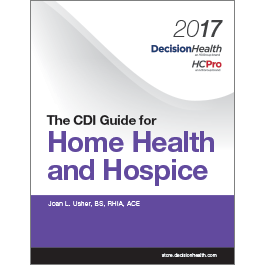Book excerpt: Tips to improve home healthcare documentation

Health and Hospice
By Joan L. Usher, BS, RHIA, ACE
When trying to effect change through CDI in home health or hospice care, one of the more difficult areas to address is external sources, such as the physician, the hospital, and the wound clinic, since these entities are not typically part of the home healthcare agency itself. However, these are important sources of documentation, and we need quality data for reimbursement and compliance purposes. Because many hospitals have a CDI department, home health can work collaboratively with our CDI peers in acute care to develop quality initiatives across the continuum.
Doing so demonstrates a commitment to patient-centered care and care sustainability, which are conditions for organizations that are part of the healthcare system, part of an accountable care organization model, or involved with bundled payment initiatives. Examples of cross-continuum measures are pain management and medication reconciliation.
Additionally, home health agencies continue to struggle with obtaining timely and complete documentation of face-to-face meetings. In fact, the lack of such documentation represented one of Palmetto GBA top 10 denial reasons in the first quarter of 2017.
This is where CDI may be able to step in and contact the physician, work with the hospitalist or community physician to identify needed documentation.
Another area for CDI involvement is a diagnosis-specific query that requests detailed specificity about the diagnosis. For example, CDI may also be able to influence change on documentation from the hospital or wound clinic.
Working with the acute care facility on such an initiative will provide savings to the hospital and will allow home health and hospice an opportunity to be heard and to make a difference at the health system level.
Editor’s note: This article is an excerpt from the CDI Guide for Home Health and Hospice.
